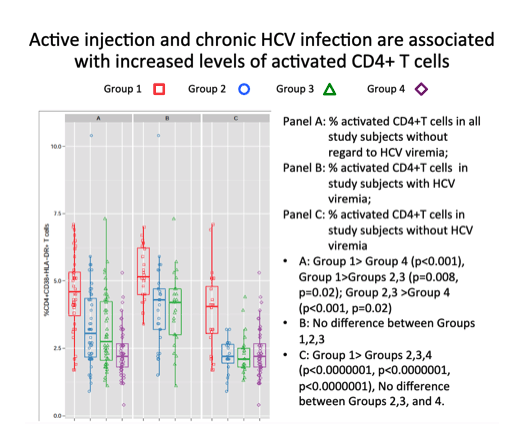 |
 |
 |
| |
Higher Immune Activation With Methadone Than Naltrexone in Opioid Users With HIV
|
| |
| |
10th IAS Conference on HIV Science (IAS 2019), July 21-24, 2019, Mexico City
Mark Mascolini
Immune activation proved significantly higher with methadone than with naltrexone as treatment for intravenous opioid use disorder in a small study of people with antiretroviral-induced HIV control [1]. Wistar Institute researchers who conducted this study noted that the clinical impact of methadone on antiretroviral-mediated immune reconstitution awaits analysis in prospective studies.
Chronic opioid use remains an intransigent problem in clusters of people with HIV. Treatment of opioid use disorder relies on mu opioid receptor (MOR) agonists such as methadone and buprenorphine or MOR antagonists such as extended-release naltrexone. Untreated opioid use spurs systemic immune activation and thus may speed progression of untreated HIV infection. The impact of MOR agonists and antagonists on microbial translocation, immune reconstitution, and HIV persistence in people taking suppressive antiretroviral therapy remains poorly understood.
To address these issues, researchers from Philadelphia's Wistar Institute, the University of Pennsylvania, and Philadelphia FIGHT compared HIV-positive people taking methadone, naltrexone, or neither agent. All participants had a viral load below 50 copies on antiretroviral therapy. Ten people were taking methadone for opioid use disorder, 6 were taking naltrexone, and 10 (controls) without opioid use disorder were taking neither methadone nor naltrexone. In each group researchers measured sCD14 (a marker of myeloid activation and microbial translocation), CD38- and CD38/HLA-DR-positive cells as percentage of CD8 cells, and cell-associated HIV DNA and RNA.
Average age was similar in the methadone, naltrexone, and control groups (49.9, 48.2, and 46.1 years). Participants had taken methadone longer than naltrexone (average 39.4 versus 18.9 months), and the methadone group had taken ART longer (average 12.5 years versus 9.6 and 10.0 in the other two groups). Nadir CD4 count was lower in the methadone group (average 186) than in the naltrexone or control group (average 257 and 222), while current CD4 count was high in all three groups (averages 551 to 608).
Average plasma sCD14 lay significantly higher with methadone (1.672 million pg/mL) than with naltrexone (1.258 million pg/mL, P= 0.008) or in the control group (1.33 million pg/mL, P = 0.005). Percentage of CD38+ cells or CD38+ HLA-DR+ cells did not differ significantly between groups. Nor did cell-associated HIV DNA or RNA.
The researchers believe their findings indicate that treatment of HIV-suppressed people with methadone versus naltrexone "results in higher immune activation and microbial translocation." They called for prospective studies to explore the impact of methadone on immune reconstitution during antiretroviral therapy.
Reference
1. Azzoni L, Vadrevu S, Lynn K, et al. HIV-infected, ART-suppressed intravenous opioid users receiving naltrexone have lower immune activation compared to similar patients receiving methadone. 10th IAS Conference on HIV Science (IAS 2019), July 21-24, 2019, Mexico City. Abstract MOPEA008.
CROI 2016: Increased Immune activation in heroin IDU - Understanding the Relative Contributions of IDU and HCV on Systemic Immune Activation

|
| |
|
 |
 |
|
|